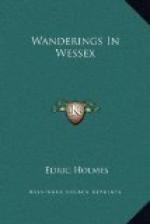As will be seen by a first glance at the central tower, Norman workmanship is in evidence in the exterior. The pinnacles and battlements that give the upper part such a curious and incongruous appearance were added in 1608. Previous to this it had a spire that was erected in the late thirteenth century, but in 1600, while a service was being conducted, “a sudden mist ariseing, all the spire steeple, being of very great height was strangely cast down; the stones battered all the lead and brake much timber of the roofe of the church, yet without anie hurt to the people.” The other tower at the western end was a 1450 addition, about which time several alterations were made, including a new clerestory. The soft and beautiful tints in the old stone are not the least charming feature of the exterior. Before entering the church the “Jack,” a figure in eighteenth-century dress that strikes the hours on a bell, should be noticed. The medley of architecture will be seen directly one enters by the north porch. The arches of the nave are of three distinct types; those at the west end being Decorated, the three in the middle late Transitional, and that nearest the tower an earlier example of this style. The choir is a mixture of late Norman and Early English. The altar is placed unusually high and this adds much to the dignity of the church. The east window is of great interest to archaeologists. Conjectured to have been constructed about 1210-20 when the apsidal east end was pulled down, it forms one of the earliest instances of “plate” tracery. Some old Italian glass has been inserted in it. On the south side of the chancel will be seen the fine tomb of John Beaufort, Duke of Somerset, grandfather of Henry VII and grandson of John of Gaunt. Above the tomb is suspended an old helmet weighing over 14 lbs. This was found during some restorations, buried in the nave. It is supposed to have belonged to the Duke. Beyond this are the canopied sedilia and piscina. On the north side is a slab of Purbeck marble which may have replaced the original memorial of King Ethelred, who was buried in the older church. The tomb on this side of the chancel is that of Gertrude, Marchioness of Exeter, and wife of the Marquis beheaded by Henry VIII. The oak benches that extend across the front of the sanctuary were placed here when the church was in Presbyterian keeping. They are usually covered with white wrappings, which, to the




